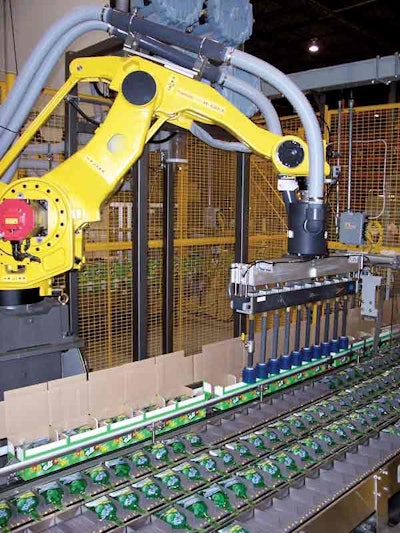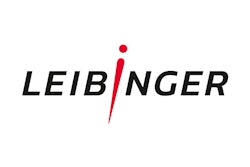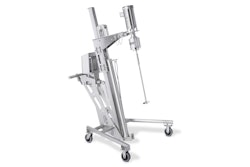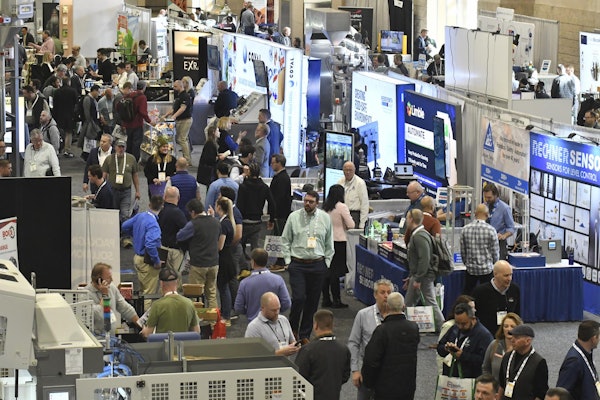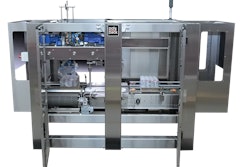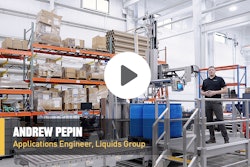It’s taken about a decade for Siptop Packaging to get the kind of automated packaging line envisioned when the firm’s unusual stand-up pouch was first developed. Management even had to make a stop along the way to acquire the assets of the packaging machinery OEM that was originally going to provide the vertical form/fill/seal equipment needed for the concept. But now, in a classic case of persistence finally paying off, Siptop Packaging appears to have most of its packaging development tasks behind it and can now focus on filling and shipping product in its unique flexible pouch.
Housed in a shiny new plant in Mississauga, Ontario, Canada, Siptop uses 12 self-designed, roll-fed, dual-head vertical form/fill/seal machines to fill 200-mL (6.75-oz) pouches of water, juice drinks, or alcoholic beverages (see sidebar for details on primary packaging). In the near future, fillers 1-4, 5-8, and 9-12 will each feed their own highly automated secondary and tertiary packaging lines. Currently, the first of these three automated lines is in place, and the balance of this story is a look at what it’s made of.
Secondary packing into corrugated trays is certainly a highlight. It’s done on a Langen (www.langeninc.com) LRC-400 robotic tray-load cell. Each corrugated tray holds 8, 10, or 24 pouches, which are loaded into the trays by one of four M420i robots supplied by Fanuc (www.fanucrobotics.com). Perfecting this part of the packaging operation was a key to the long-term viability of the Siptop concept, says Grant Joyce, the company’s president and CEO.
“We knew secondary packaging was going to be a huge challenge,” says Joyce. “How do you convey and pack such a difficult-to-handle-pouch? After working with some smaller firms on what amounted to a custom solution and not reaching the automation outcome we wanted, we decided to seek a major company with experience in robotics and a long history of applications. That’s what led us to Langen.”
It didn’t hurt, either, that Langen’s offices are five minutes away. “What they came up with is really state of the art,” adds Joyce.
Vacuum a key issue
Much of the difficulty Siptop encountered in trying to perfect its secondary packaging operations centered on the interface between vacuum grippers and the pouches they were trying to grip. The very nature of the pouch itself, especially if anything like the smallest wrinkle presented itself, led to a situation where vacuum grippers too often dropped their pouches before reaching the corrugated tray. A key characteristic of the Langen system compared to those that preceded it is that vacuum is created by a regenerative blower capable of producing far more vacuum power than the pumps used traditionally in similar packaging operations. Also helpful is that the end-of-arm tooling uses one large suction cup per pouch.
Upstream from the robots is an automatic case erector from Imball (www.imball.it). It sends cases down two conveyors into the Langen cell. One conveyor feeds each pair of robots. Conveyor connections, it should be pointed out, play a critical role in tying together this collection of complex and impressive packaging equipment. Descon (www.desconveyor.com) and Htech, Inc. (www.htech.ca) provided most of the conveyors.
The robots in the LRC-400 are programmed to pick from whichever lanes are full. For 8-count trays, five trays are filled at a time, and pouches are in a 2 x 4-high format. The 10-count trays are also loaded five at a time, though the pattern is 2 x 5-high. The 24-count trays are packed three at a time and the pattern is 3 x 8-high. Also, one of the 10 suction cups is turned off so that the end effector can cycle eight times and produce three cartons each having 24 pouches.
Changeover from an 8- to a 10-count carton is accomplished with little more than a touch of the button at the controls panel. To switch from these smaller sizes to the 24-count size involves changing out a cam plate, but even here the changeover requires only 30 minutes, says Joyce.
Pouches flat on their conveyor belts are conveyed right up to the robotic cell in as many as eight parallel lanes. Running perpendicular to these eight lanes are eight flighted conveyors into which pouches drop one at a time. It’s from these flighted conveyors that the robots do their picking. Individual vacuum cups are cam-driven so that they pick at a wider pitch and then collapse to a tighter pitch so that the end effector fits smoothly into the corrugated trays. Supplied by Lithotech (www.norampac.com), the B-flute corrugated gets its graphic pop from offset printing in five colors.
“Each pair of robots runs independently, so we can shut down one side and still run the other,” says Joyce. “We also wanted the system to be flexible enough to let us run as many fillers as we like.” If just one dual-head filler is in production, the robots operate at a fairly relaxed pace. As additional filling comes back up, the robots automatically respond by stepping up the pace. Sensors, software, and PLC control keep the robots humming at whatever speed conditions are required.
On to tray sealing
Corrugated trays filled with pouches exit the robotic cell on parallel conveyors. These merge into a single conveyor that leads to an Imball tray sealer and then to a Leibinger (www.leibinger.com) ink-jet coder that puts production code information on the corrugated trays.
Trays move next through a Douglas (www.douglas-machine.com) Contour shrink wrapper. It has a servo-driven film wrapping wand and a patent-pending tunnel that uses advanced heat and airflow management to deliver tightly wrapped trays. “Tremendous quality,” says Joyce, when asked what led to this particular machine.
The 24-count trays are not bundled and the 8- and 10-count trays are bundled four at a time. Exiting the shrink tunnel, bundles pass through a Weber (www.webermarking.com) print-and-apply labeler with a Sato (www.satoamerica.com) print engine integrated into it. This device tamps on a thermal-transfer-printed label carrying date-code information and a bar code.
Bringing the line to a close are palletizing and stretch wrapping. A Langen LRC-600 palletizer cell comprises two M410i Fanuc robots. Fitted with multi-functional end-of-arm tooling designed by Langen, the robots pick fresh pallets from a pallet dispenser, place slip sheets as needed, and place and arrange shrink wrapped bundles in a variety of patterns.
“Both of these palletizers are capable of a pallet a minute,” says Joyce. “The end-of-arm tooling uses both mechanical and vacuum pickup. Also, it can configure the incoming bundles in three different patterns. And again, changeover is absolutely minimal.”
This robotic cell will handle the output of all three upstream robotic tray packers when the final two are installed. All pallets from this cell are wrapped by a Highlight Industries (www.highlightindustries.com) stretch wrapper. The Freedom 6500 wrapper offers 20 RPM turntable speeds and has adjustable pre-stretch that makes it possible to economize on the amount of stretch film used. Exiting the wrapper, it’s on to the warehouse and shipment to the marketplace.
“We’ve been selling the 10%-juice-content Rip ’n Sip in the U.S. for about two years now, and it continues to grow,” says Joyce. “Northern Pure purified water we’re just launching, and soon we’ll launch the Iced Vodka product, IV. You put the IV pouch in the freezer and it turns into a vodka slushie. It’s very unique in the alcoholic beverages category, and we think it gives us a bright future.”
